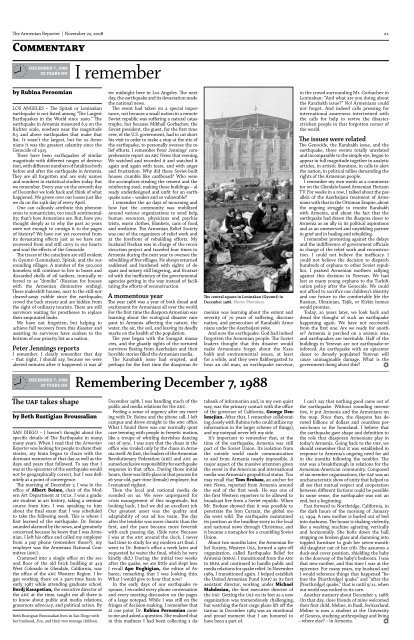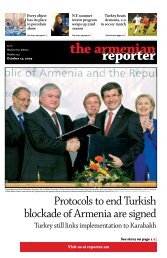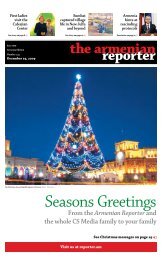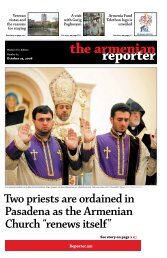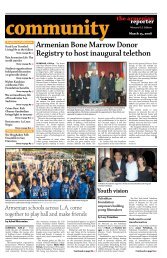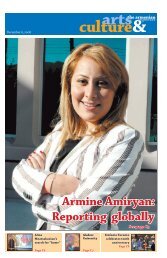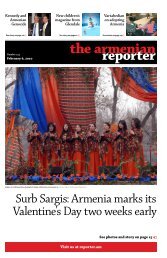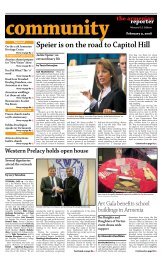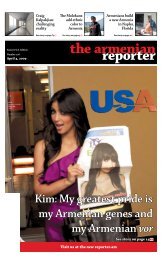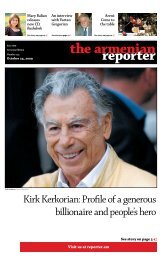And for this we are thankful.... - Armenian Reporter
And for this we are thankful.... - Armenian Reporter
And for this we are thankful.... - Armenian Reporter
Create successful ePaper yourself
Turn your PDF publications into a flip-book with our unique Google optimized e-Paper software.
The <strong>Armenian</strong> <strong>Reporter</strong> | November 22, 2008 21CommentaryDecember 7, 198820 years onI rememberby Rubina PeroomianLOS ANGELES – The Spitak or Leninakanearthquake is not listed among “The LargestEarthquakes in the World since 1900.” Theearthquake in Armenia measured 6.9 on theRichter scale, nowhere near the magnitude8.5 and above earthquakes that make thatlist. It wasn’t the largest, but <strong>for</strong> us <strong>Armenian</strong>sit was the greatest calamity since theGenocide of 1915.There have been earthquakes of similarmagnitude with different ranges of destruction,with different numbers of fatalities bothbe<strong>for</strong>e and after the earthquake in Armenia.They <strong>are</strong> all <strong>for</strong>gotten and <strong>are</strong> only namesand numbers in statistical studies today. But<strong>we</strong> remember. Every year on the seventh dayof December <strong>we</strong> look back and think of whathappened. We grieve over our losses just like<strong>we</strong> do on the 24th day of every April.One can callously attribute <strong>this</strong> phenomenonto romanticism, too much sentimentality;that’s how <strong>Armenian</strong>s <strong>are</strong>. But, have youthought deeply as to why the past 20 years<strong>we</strong>re not enough to consign it to the pagesof history? We have not yet recovered fromits devastating effects just as <strong>we</strong> have notrecovered from and still carry in our heartsand soul the effects of the Genocide.The traces of the cataclysm <strong>are</strong> still evidentin Gyumri (Leninakan), Spitak, and the surroundingvillages. A number of the 500,000homeless still continue to live in boxes anddiscarded shells of oil tankers, ironically referredto as “domiks” (Russian <strong>for</strong> houseswith the <strong>Armenian</strong> diminutive ending).These makeshift houses, next to the still-notcle<strong>are</strong>d-awayrubble since the earthquake,crowd the back streets and <strong>are</strong> hidden fromthe sight of ordinary tourists. There <strong>are</strong> stillsurvivors waiting <strong>for</strong> prostheses to replacetheir amputated limbs.We have not <strong>for</strong>gotten, but helping toachieve full recovery from <strong>this</strong> disaster andassisting its survivors have sunken to thebottom of our priority list as a nation.December 7, 198820 years onThe UAF takes shapeby Beth Rustigian BroussalianSAN DIEGO – I haven’t thought about thespecific details of The Earthquake in many,many years. When I read that the <strong>Armenian</strong><strong>Reporter</strong> was looking <strong>for</strong> people to sh<strong>are</strong> theirstories, my brain began to churn with thedormant memories of that day as <strong>we</strong>ll as thedays and years that follo<strong>we</strong>d. To say that Iwas at the epicenter of the earthquake wouldnot be geographically correct, but I was definitelyat a point of convergence.The morning of December 7, I was in theoffice of Albert Boime, chair of the ModernArt Department at UCLA. I was a graduatestudent in art history, taking a seminarcourse from him. I was speaking to himabout the final exam that I was scheduledto take the following <strong>we</strong>ek. This is where Ifirst learned of the earthquake. Dr. Boimesounded alarmed by the news, and genuinelyconcerned because he knew that I was <strong>Armenian</strong>.I left his office and called my employerfrom a pay phone (remember those?); myemployer was the <strong>Armenian</strong> National Committee(ANC).Crammed into a single office on the secondfloor of the old brick building at 419West Colorado in Glendale, Cali<strong>for</strong>nia, wasthe office of the ANC Western Region. I beganworking there on a part-time basis inearly 1987 while attending graduate school.Berdj Karapetian, the executive director ofthe ANC at the time, taught me all there isto know about public and media relations,grassroots advocacy, and political action. ByBeth Rustigian Broussalian lives in San Diego withher husband, Jim, and their two teenage children.Peter Jennings reportsI remember. I clearly remember that day– that night, I should say, because <strong>we</strong> <strong>we</strong>realerted minutes after it happened: it was aftermidnight here in Los Angeles. The nextday, the earthquake and its devastation madethe national news.The event had taken on a special importance,not because a small nation in a remoteSoviet republic was suffering a natural catastrophe,but because Mikhail Gorbachev, theSoviet president, the guest, <strong>for</strong> the first timeever, of the U.S. government, had to cut shor<strong>this</strong> visit in order to make a stop at the site ofthe earthquake, to personally oversee the reliefef<strong>for</strong>ts. I remember Peter Jennings’ comprehensivereport on ABC News that evening.We watched and recorded it and watched itagain and again with tears, and with angerand frustration. Why did these Soviet-builthouses crumble like cardboard? Who <strong>we</strong>rethe accomplices stealing the cement and therein<strong>for</strong>cing steel, making these buildings – alreadyunderdesigned and unfit <strong>for</strong> an earthquakezone – <strong>we</strong>aker and so vulnerable?I remember the 40 days of mourning andhow fast the community was mobilizedaround various organizations to send help,human resources, physicians and psychiatrists,warm clothes, blankets, cans of food,and medicine. The <strong>Armenian</strong> Relief Societywas one of the organizers of relief work andat the <strong>for</strong>efront of rebuilding ef<strong>for</strong>ts. Myhusband Neshan was in charge of the reconstructionproject and traveled four times toArmenia during the next year to oversee therebuilding of five villages. He always returnedsaddened and burdened with sights of despairand misery still lingering, and frustratedwith the inefficiency of the governmentalagencies getting in the way instead of facilitatingthe ef<strong>for</strong>ts of reconstruction.Remembering December 7, 1988The central squ<strong>are</strong> in Leninakan (Gyumri) inDecember 1988. Photo: Photolure.A momentous yearThe year 1988 was a year of both dread andexcitement <strong>for</strong> <strong>Armenian</strong>s all over the world.For the first time the diaspora <strong>Armenian</strong> waslearning about the ecological disaster rampantin Armenia affecting the nature, thewater, the air, the soil, and leaving its deadlymarks on the health of the population.The year began with the Sumgait massacres,and the ghastly sights of the torturedsurvivors fleeing from Azerbaijan and theirhorrible stories filled the <strong>Armenian</strong> media.The Karabakh issue had erupted, andperhaps <strong>for</strong> the first time the diasporan <strong>Armenian</strong>was learning about the extent andseverity of 70 years of suffering, discrimination,and persecution of Karabakh <strong>Armenian</strong>sunder the Azerbaijani yoke.<strong>And</strong> now the earthquake. God had indeed<strong>for</strong>gotten the <strong>Armenian</strong> people. The Sovietleaders thought that <strong>this</strong> disaster wouldmake <strong>Armenian</strong>s <strong>for</strong>get about the Karabakhand environmental issues, at least<strong>for</strong> a while, and they <strong>we</strong>re flabbergasted tohear an old man, an earthquake survivor,December 1988, I was handling much of thepublic and media relations <strong>for</strong> the ANC.Feeling a sense of urgency after my meetingwith Dr. Boime and the phone call, I leftcampus and drove straight to the ANC office.What I found there was our normally quietcave teeming with people in frenetic motion,like a troupe of whirling dervishes dancingout of sync. I was sure that the chaos in theoffice was rivaled only by the chaos in Armeniaitself. At first, the leaders of the <strong>Armenian</strong>Revolutionary Federation (ARF) and ANC assumedexclusive responsibility <strong>for</strong> earthquakeresponse in that office. During those initialhours, there was little place in that process <strong>for</strong>26-year-old, part-time (female) employee, butI remained vigilant.Then the local and national media descendedon us. We <strong>we</strong>re unprep<strong>are</strong>d <strong>for</strong>crisis management of <strong>this</strong> magnitude, butlooking back, I feel <strong>we</strong> did an excellent job.Our greatest asset was the quality andadaptability of our ad hoc team. The dayafter the temblor was more chaotic than thefirst, and the pace became more feverishwith each passing day. (Side note: BecauseI was at the ANC around the clock, I neverhad time to study <strong>for</strong> my modern art final. I<strong>we</strong>nt to Dr. Boime’s office a <strong>we</strong>ek later andrequested he waive the final, which he verykindly did.) During the initial two <strong>we</strong>eksafter the quake, <strong>we</strong> ate little and slept less.I recall Apo Boghigian, the editor of Asb<strong>are</strong>z,remarking that I was looking thin.What I would give to hear that now!In the early days of our earthquake response,I recorded every phone conversationand every meeting discussion on the pagesof a large notepad. While I was still on thefringes of decision-making, I remember thatat one point Dr. Rubina Peroomian cameto me and asked a question. She realized thatin <strong>this</strong> madness I had been collecting a databankof in<strong>for</strong>mation and, in my own quietway, was the primary contact with the officeof the governor of Cali<strong>for</strong>nia, George Deukmejian.After that, I remember collaboratingclosely with Rubina (who could utilize myin<strong>for</strong>mation in the larger scheme of things),and my notepad never left my side.It’s important to remember that, at thetime of the earthquake, Armenia was stillpart of the Soviet Union. Its isolation fromthe outside world made communicationto and from Armenia nearly impossible. Amajor aspect of the massive attention giventhe event in the American and internationalmedia was Armenia’s geopolitical status. Youmay recall that Tom Brokaw, an anchor <strong>for</strong>NBC News, reported from Armenia aroundthe end of the first <strong>we</strong>ek. He was one ofthe first Western reporters to be allo<strong>we</strong>d tobroadcast live from a Soviet republic. WhenMr. Brokaw sho<strong>we</strong>d that it was possible topenetrate the Iron Curtain, the global media<strong>we</strong>nt wild. The earthquake maintainedits position as the headline story in the localand national news through Christmas, andit became a metaphor <strong>for</strong> a crumbling SovietUnion.About two months later, the <strong>Armenian</strong> ReliefSociety, Western USA, <strong>for</strong>med a spin-of<strong>for</strong>ganization, called Earthquake Relief <strong>for</strong>Armenia (ERFA). I transitioned from the ANCto ERFA and continued to handle public andmedia relations <strong>for</strong> quake relief. In November1989, I transitioned again. I helped establishthe United <strong>Armenian</strong> Fund (UAF) as its firstassistant director, working under MichaelMahdesian, the first executive director ofthe UAF. Getting the UAF on its feet as a neworganization was tremendously challenging,but watching the first cargo plane lift off thetarmac in December 1989 was an emotionaland proud moment that I am honored tohave been a part of.in the crowd surrounding Mr. Gorbachev inLeninakan: “<strong>And</strong> what <strong>are</strong> you doing aboutthe Karabakh issue?” No! <strong>Armenian</strong>s couldnot <strong>for</strong>get. <strong>And</strong> indeed calls pressing <strong>for</strong>international aw<strong>are</strong>ness intertwined withthe calls <strong>for</strong> help to revive the disasterstrickenpeople in that <strong>for</strong>gotten corner ofthe world.The issues <strong>we</strong>re relatedThe Genocide, the Karabakh issue, and theearthquake, three events totally unrelatedand incomparable to the simple eye, began toappear in full magnitude together in analyticarticles, in artistic literature, in calls to alertthe nation, in political rallies demanding therights of the <strong>Armenian</strong> people.I remember my own words as a commentatoron the Glendale-based <strong>Armenian</strong> HorizonTV. For <strong>we</strong>eks in a row, I talked about the parallelsof the Azerbaijani treatment of <strong>Armenian</strong>swith that in the Ottoman Empire, aboutthe ongoing struggle to reunite Karabakhwith Armenia, and about the fact that theearthquake had drawn the diaspora closer toArmenia as an ally in its political aspirationsand as an unreserved and unyielding partnerin grief and in healing and rebuilding.I remember protesting against the delaysand the indifference of government officialsin charge of the relief work and reconstruction.I could not believe the inefficacy. Icould not believe the decision to dispatchhundreds of orphans to other Soviet republics.I praised <strong>Armenian</strong> mothers rallyingagainst <strong>this</strong> decision in Yerevan. We hadlost so many young orphans to the Turkificationpolicy after the Genocide. We couldnot af<strong>for</strong>d to sacrifice our children’s identityand our future to the com<strong>for</strong>table life theRussian, Ukrainian, Tajik, or Kirkiz homeswould promise.Today, 20 years later, <strong>we</strong> look back anddread the thought of such an earthquakehappening again. We have not recoveredfrom the first one. Are <strong>we</strong> ready <strong>for</strong> another?Armenia is perched on a seismic <strong>are</strong>a,and earthquakes <strong>are</strong> inevitable. Half of thebuildings in Yerevan <strong>are</strong> not earthquake-rein<strong>for</strong>ced.An earthquake with an epicentercloser to densely populated Yerevan willcause unimaginable damage. What is thegovernment doing about <strong>this</strong>?fI can’t say that nothing good came out ofthe earthquake. Without sounding insensitive,it put Armenia and the <strong>Armenian</strong>s onthe map. Since then, the diaspora has devotedbillions of dollars and countless person-hoursto the homeland. I believe thatthe earthquake gave shape and definition tothe role that diasporan <strong>Armenian</strong>s play intoday’s Armenia. Going back to the UAF, <strong>we</strong>should remember that it was established inresponse to Armenia’s ongoing need <strong>for</strong> aidin the months following the temblor. TheUAF was a breakthrough in relations <strong>for</strong> the<strong>Armenian</strong>-American community. Composedof six member organizations, the UAF was anuncharacteristic show of unity that helped usall see that mutual respect and cooperationbet<strong>we</strong>en different factions could be possible.In some sense, the earthquake was not anend, but a beginning.Fast <strong>for</strong>ward to Northridge, Cali<strong>for</strong>nia, inthe dark hours of the morning of January17, 1994. A new mother is hurled out of bedinto darkness. The house is shaking violently,like a washing machine agitating verticallyand horizontally. She bolts down the hall,stepping on broken glass and slamming intotoppled furniture to grab her seven-montholddaughter out of her crib. She assumes aduck-and-cover position, shielding the babyin the doorway of the baby’s bedroom. I wasthat new mother, and <strong>this</strong> time I was at theepicenter. For many years, my husband andI would reference things that happened “be<strong>for</strong>ethe [Northridge] quake” and “after the[Northridge] quake,” that is until 9/11, whenour world was rocked to its core.Another memory about December 7, 1988:On that day, close friends of mine <strong>we</strong>lcomedtheir first child, Meline, in Basil, Switzerland.Meline is now a student at the Universityof Geneva, studying anthropology and living– where else? – in Armenia. f


